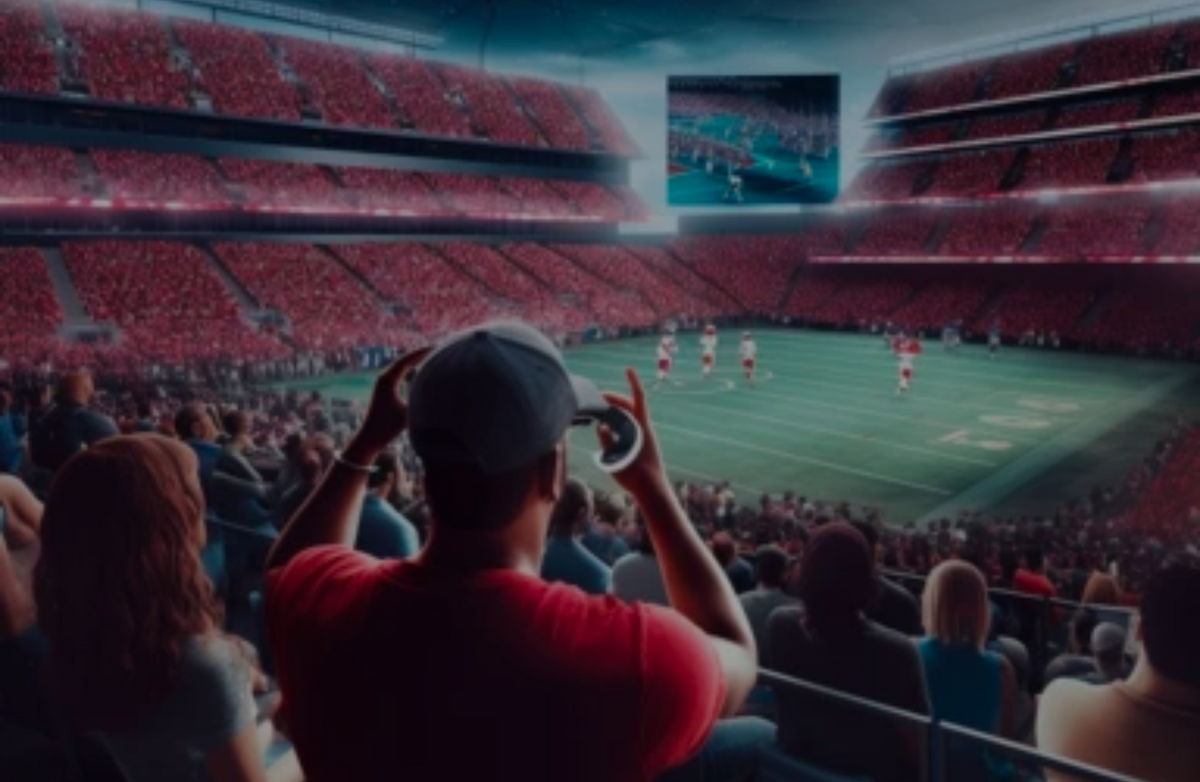Enhancing the In-Stadium Fan Experience

Stadium attendance has declined. A review carried out pre-Covid of 10-year changes in home game attendance for professional sports teams across North America found that average attendance had decreased by 10%.
The viewing habits of younger generations have also changed. In fact, there has been a major decline in sports fans including Millenials and Gen Z. If we want to entice younger fans to return to the stadium, and improve global fan loyalty, we have to offer them more engagement, interactivity, and gamification.
What’s more, it is estimated that between 10% and 40% of overall revenues come from in-person stadium purchases, so it is crucial that fans be motivated to attend games. But how can the sports and entertainment industry attract fans and enhance their stadium experience? One way is to provide them with in-stadium mobile video and XR.
Create an Unforgettable In-stadium Experience
Imagine you’re in the stadium and your favorite team has just scored at the other end of the pitch. However, you didn't have a clear view and missed the play. You immediately open the app on your phone to replay the goal, via different angles in high-quality video. You’re even able to visualize the goal, and the build-up, with augmented reality (AR) showing the speed and trajectory of the ball.
Later, your app suggests a contest to choose the next goalscorer. You might just win the jersey of the player who scored! Next, you put on your AR glasses so you can not only follow the game on the field and watch alternative angles in pristine-quality, including tunnel and dugout views, but also check out game statistics and purchase merchandise.
The future of stadium services is a complete immersive experience reducing idle time, integrating gaming and betting with an unparalleled quality of experience. This enables monetization for sports teams and network operators. With improved connectivity and latency, you can introduce a whole new breed of viewing experiences, including extended reality (XR).
Transform and Monetize the In-stadium Experience
As Apple Vision Pro’s headset and other similar products hit the market, demand for XR enhanced experiences will increase.
XR technologies will allow fans virtual access to the entire stadium with high-quality live video and highlights from any angle. From their phone and AR glasses, they’ll be able to follow the game and view statistics overlaying the physical action, as well as heatmaps, distances, speeds, plus shot trails and replays from anywhere in the stadium. They’ll get the emotional live-action experience along with an in-depth game view via a seamless user experience (UX) that delivers interactive virtual enhancements of statistics and 3D visualizations mapped to the pitch and the venue.
In addition, engagement among younger fan communities will increase when integrating gamification and social elements. Revenue generation will be possible through merchandising, targeted advertising, subscriptions, ticket sales, and betting, available during the game and on-screen. With AR glasses, it’s possible to transform the stadium into an open canvas that can be populated with content as well as advertising and product merchandising associated with the game, team, or players and adapted to each fan’s interests and behaviors.
Solve In-stadium Video Delivery Challenges
To date, one key challenge when delivering an enhanced stadium experience has been poor connectivity. This is largely because broadband access and video delivery in densely populated venues can be extremely challenging. With venues seating tens of thousands of fans worldwide, the video distribution can be cumbersome. It only takes a few hundred people receiving HD quality video feeds at the same time to saturate a mobile network. This is largely insufficient to deliver a great stadium experience. Latency can also be a real drag. For an optimal experience, live feeds must be delivered with the lowest latency possible so fans can follow the action in real time from multiple angles.
To solve the connectivity bottleneck, audience-aware streaming minimizing the bitrate while preserving quality combined with an elastic cloud-native CDN sized according to the audience can be deployed. Access technologies such as 5G can be used. 5G offers the possibility of distributing content using Multicast-Broadcast (5GMBS) or 5G-Broadcast to enable network operators to reduce traffic peaks, power, and infrastructure costs. Latency can be decreased to reach near-live delivery using Common Media Application Format (CMAF) low latency in combination with multi-access edge computing (5G MEC). Combined, these features give shape to a complete service delivery platform allowing fans to seamlessly access live and on-demand feeds.
Attract and Engage Fans
Delivering an enhanced in-stadium experience is the key to attracting and engaging fans. Ateme and Accedo have partnered to make this a reality. With Ateme’s 5G solution that combines cost-effective high video quality, low latency, elastic CDN, targeted advertising, and multicast-broadcast technology, and Accedo’s next-generation in-stadium video platform enhanced with XR, fans will experience attending live sports like never before. Accedo's XR solution (Xtend) can help turn your visitors into active fans by allowing them to interact with a uniquely branded XR fan interface overlaying virtual live statistics, gamification, and social experiences. Your existing services could simply be extended with immersive offerings and expanded to any XR platform (mobile AR, AR glasses, MR/VR headsets) to increase fan engagement, reach younger audiences, and unlock new revenue streams.
Wed, 08/23/2023 - 14:14
Author: cbilt
Date: 2023-09-06
Source: https://www.fiercewireless.com/sponsored/enhancing-stadium-fan-experience-0





